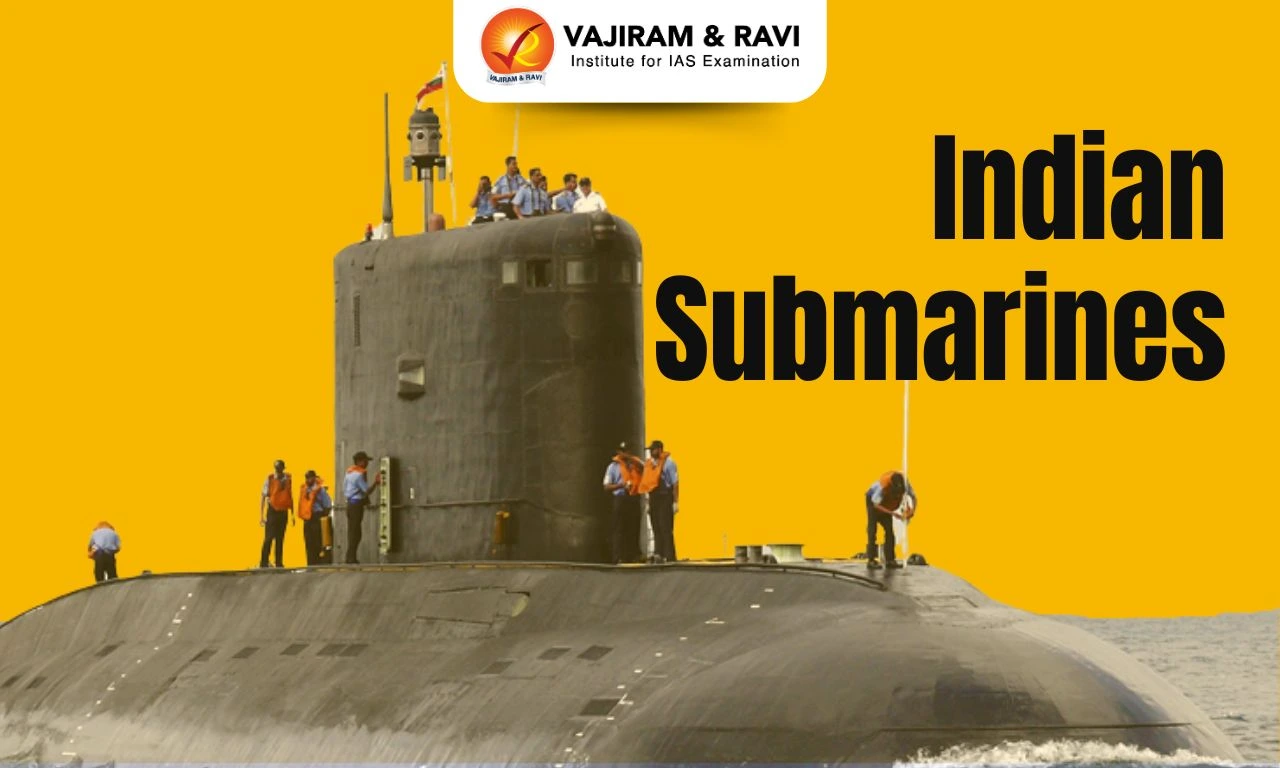Submarines are specialised watercrafts capable of independent underwater operations using onboard power and systems for extended periods. They play a vital role in naval warfare due to their stealth and agility. As a key part of maritime defence, they can conduct intelligence gathering and anti-submarine operations. Modern submarines have advanced navigation, communication, and weapons systems, making them formidable naval assets.
India has significant submarine platforms supporting its maritime interests, encompassing different classes of diesel-electric attack submarines as well as nuclear-powered submarines with the ability to launch ballistic missiles. Alongside these existing vessels, India is developing next-generation submarines, ships and destroyers to continue strengthening its naval capabilities.
Submarine Technology
Submarines are notable for their strategic importance and are equipped with a wide range of advanced technologies.

Propulsion
Submarines use a variety of propulsion systems, such as battery-electric propulsion, diesel-electric engines, Air-independent propulsion, and nuclear reactors.
- Air-independent propulsion: It provides extra underwater endurance to the non-nuclear submarines (SSKs) so that they can stay underwater for a longer time (two weeks).
- Without this, they have to come to the surface every 48 hours.
- AIP makes the non-nuclear submarines virtually silent and even more stealthier than the nuclear submarines. The reactors of nuclear submarines make some amount of detectable noise, making them vulnerable.
- Three types of AIP technology are used – Steam engine (ethanol and oxygen), Stirling engine (liquid oxygen and diesel fuel) and fuel cells (Hydrogen cell, lithium-ion battery, etc.).
Armaments
Submarines carry both offensive and defensive weapons.
- Offensive weapons: These can be nuclear as well as conventional, depending on the objectives.
- Submarines are equipped with torpedoes, cruise missiles, or ballistic missiles.
- Submarine-launched ballistic missiles with nuclear warheads are the most important armament on submarines, which makes them strategic rather than merely offensive.
Navigation
Submarines navigate through the ocean virtually blind due to limited light penetration. They use GPS for surface navigation, and inertial guidance systems for underwater navigation.
- Inertial guidance systems: Underwater, they use inertial guidance systems (electric and mechanical) using gyroscopes.
- These systems are accurate for 150 hours and must be realigned with other surface-dependent navigational systems like GPS, radio, radar, and satellite.
- SONAR: Submarines use SONAR technology, which emits and analyses sound waves, to detect and track other vessels.
- Both active (sound generated by submarines and then reflected by the target) and passive (sound generated by the target) sonars are used.
- They aid submarines in detecting obstacles to the Earth’s magnetic field as well as deterring any underwater threat to the submarines.
Communication
Submarines use radio communication systems at Very Low Frequency (VLF) and Extremely Low Frequency (ELF) to transmit and receive messages.
- They can establish long-range, secure, and high-bandwidth communication links with satellites.
- Communication buoys can be deployed at the surface for communication without the need to surface.
- Underwater telephone systems allow voice communication and are used for tactical or operational coordination. These systems are designed to protect confidentiality and integrity.
- Submarine communication systems are typically integrated with the broader command and control infrastructure for seamless information exchange.

Types of Submarines
Based on propulsion technology, submarines can be categorised into two types – Diesel-powered conventional attack submarines (SSKs) and Nuclear-powered submarines (SSNs and SSBNs).
| Submarine Type | Key Features |
| SSK | – SSK stands for “Diesel-Electric Attack Submarine”
– Features:
– Applications: They are used for coastal defence, anti-submarine warfare, intelligence gathering, and reconnaissance. – Examples (without AIP): Gotland-class submarine used by the Swedish Navy. – Examples (with AIP): The Kilo-class submarine is used by various navies around the world. |
| SSN | – SSN stands for “Submersible Ship Nuclear” and is a nuclear-powered Attack Submarine.
– Features:
– Applications: They are primarily used for offensive operations, such as anti-ship and anti-submarine warfare, intelligence gathering, and surveillance. – Example: The United States Navy operates several classes of SSN submarines, including the Virginia-class submarines. |
| SSBN | – SSBN stands for Sub-Surface Ballistic Nuclear as they are capable of launching ballistic missiles.
– Features: SSBN submarines are designed to carry and launch SLBMs.
– Applications: SSBN submarines mainly serve for strategic nuclear deterrence for a country. – Example: The United States Navy operates the Ohio-class SSBN submarines. |
Submarines in India
India deploys a spectrum of conventional and nuclear-powered submarines equipped with suitable sensor suites, armaments and engines fulfilling niche maritime operations.
India has three classes of submarines – the Shishumar class, the Sindhughosh class, and the indigenously developed Kalvari class.
- Shishumar class: These 4 submarines were commissioned under technology transfer from Germany.
- They carry advanced sensory capabilities optimised for anti-sub and anti-ship warfare to dominate the Arabian Sea.
- The commissioned Sishumar class submarines are INS Shishumar, INS Shankush, INS Shalki and INS Shankul.
- Sindhughosh class – It includes 7 active Russian-origin Kilo-class submarines.
- A total of 10 submarines were commissioned, 3 of them have been decommissioned.
- They contain satellite sensors, radar, sonar and electronic surveillance as well as anti-ship and anti-submarine weaponry.
- The commissioned Sindhughosh class submarines are INS Sindhughosh, INS Sindhudhvaj, INS Sindhuraj, INS Sindhuvir, INS Sindhuratna and INS Sindhukesari.
- Kalvari class – These are the indigenously built six diesel-electric submarines of Contemporary Barracuda designs under technology transfer from France’s Scorpene class submarines, built at Mazagon Dock.
- Names of the Kalvari class submarines (commissioned only) are INS Kalvari, INS Khanderi, INS Karanj, INS Vela and INS Vagir.
- These submarines have been built under the name of Project 75.
- The sixth and final submarine under Project 75, INS Vagsheer, will be delivered to the Indian Navy in 2024.
- Further, these submarines are to be loaded with the Air Independent Propulsion under Project 75 (I). All the submarines under Project 75I are under development.
Nuclear-Powered Attack Submarines (SSN)
India presently does not have any nuclear-powered attack submarines (SSNs) in service. The Akula class submarine INS Chakra II, leased from Russia, has been decommissioned in 2021.
- However, India has reinforced its SSN lineup by ordering another Akula class submarine (INS Chakra III), planned for induction in 2025.
- Moreover, there are plans for indigenous Project 75 Alpha SSNs in the future.
Nuclear ballistic missile submarines (SSBN)
India presently has one SSBN – INS Arihant, an Arihant Class SSBNwhich has been developed indigenously under the Advanced Technology Vessel program.
- INS Arihant (S2): Launched in 2009 and commissioned in 2016, it features a double-hull with advanced sensors, periscopes, and weapon systems, including strategic SLBMs.
- It can carry either 12 K-15 (Sagarika) missiles with 750 Kms range or 4 K-4 missiles with 3500 Kms range.
- INS Arighat (S3): It is India’s second SSBN, being built as an upgraded version of INS Arihant.
- Further, S4 and S5 SSBNs are in the planning phase.
Submarines in India Significance
A modern and highly capable submarine fleet holds great significance for advancing the naval strategy and maritime interests of any country including India.
- Completes India’s Nuclear Triad: INS Arihant is capable of launching submarine-launched ballistic missiles (SLBMs) providing assured second-strike capability.
- This enables India to retaliate massively even after a hypothetical first nuclear strike has destroyed land-based missiles and air bases.
- This reinforces India’s nuclear deterrence stability and provides a balance of power in the Indo-Pacific region.
- Makes India a naval power in the Indian Ocean: The offensive capability of India’s growing submarine fleet acts as a powerful deterrent against adversarial actions both on land and sea-based borders.
- They contribute to greater maritime stability by acting as a deterrent to aggressive posturing.
- Access denial: It involves blocking enemy naval formations using mines, torpedoes, and anti-ship missiles, while diesel submarines are designed to impede maritime movement during conflicts.
- Sea control: It provides control of parts of the sea and contests dominance through surprise missile attacks.
- It secures the Sea lines of Communication around India.
- India requires expanded underwater capability to secure expanding strategic maritime spaces in the Indo-Pacific.
- Intelligence, Surveillance and Reconnaissance (ISR): Submarines gather critical maritime intelligence through sustained underwater surveillance of global hotspots and chokepoints using Electronic Support Measures(ESM) and Electronic Counter Measures (ECM) suites.
Issues with the Submarine Capability of India
While India has made remarkable progress in submarine technologies, several challenges remain for smooth induction as well as operations:
- Lack of strength: India lacks the total number of submarines, needed for its presence in the large Indian Ocean and two adversaries across the border. Currently, India only has 16 SSKs, 1 SSBN and 0 SSN.
- Even with SSKs, India only has 6 AIP-SSKs (the last one is to be commissioned soon).
- The INS Arihant is armed with 12 indigenously developed K-15 SLBMs, with a range of just 750 km. These SLBMs are ineffective against China.
- The K-4 missiles, with a 3500 km range, have been trialled but are yet to be commissioned in service.
- This implies the asymmetry of naval power vis-a-vis China.
- Modernisation constraints:
- Budgetary limitations and project delays have impacted submarine force levels and technological currency.
- The challenges lie in maintaining indigenous submarine development while keeping pace with rapid technological advancements in undersea warfare and stealth technologies.
India’s submarines must adapt to changing undersea dynamics, including advanced anti-submarine warfare capabilities and evolving threats
Last updated on July, 2025
→ UPSC Notification 2025 was released on 22nd January 2025.
→ UPSC Prelims Result 2025 is out now for the CSE held on 25 May 2025.
→ UPSC Prelims Question Paper 2025 and Unofficial Prelims Answer Key 2025 are available now.
→ UPSC Calendar 2026 is released on 15th May, 2025.
→ The UPSC Vacancy 2025 were released 1129, out of which 979 were for UPSC CSE and remaining 150 are for UPSC IFoS.
→ UPSC Mains 2025 will be conducted on 22nd August 2025.
→ UPSC Prelims 2026 will be conducted on 24th May, 2026 & UPSC Mains 2026 will be conducted on 21st August 2026.
→ The UPSC Selection Process is of 3 stages-Prelims, Mains and Interview.
→ UPSC Result 2024 is released with latest UPSC Marksheet 2024. Check Now!
→ UPSC Toppers List 2024 is released now. Shakti Dubey is UPSC AIR 1 2024 Topper.
→ Also check Best IAS Coaching in Delhi
Tags: indian submarines quest












